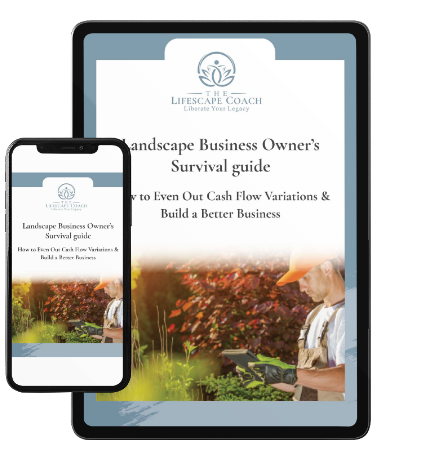Landscape Business Survey Analysis - Part III: Where do you think you can improve your business?
In Part 3 of our Business Survey Analysis series we’re going to take a closer look at what landscape business owners think can improve their businesses. Of course, some of you might say “that’s easy – more time, money, and clients!” but it’s usually something more than that. Improving your business can be a real challenge because it often means you have to take something apart to get it corrected.
It’s easy to complain about what’s not working, and usually that’s exactly what’s being neglected. It’s human nature to avoid things we don’t like and so the areas in our businesses that need the most work are typically the areas that we tend to avoid working on.
Internationally-renowned author, speaker, and prosperity coach Bob Proctor has a saying every business owner should take to heart:
“What you think about you bring about.”
The meaning is simple – wherever you put your focus is where you will see results. The trick is making that focus positive. A negative attitude yields negative results. Likewise, if you take a positive approach and truly believe a workable solution is possible, that solution will come to fruition.

So what areas in their organizations do landscape business owners feel need the most attention? Here’s how they ranked, from the area needing the most improvement to the least:
1. Business organization
Being in business has a way of forcing you, at some point, to shift your focus to the business side of your organization. For me, the real “a-ha!” moment came when a coach I had hired asked me to submit several pieces of information before one of our early sessions, including an organizational chart. Hmm, I knew what that was, but I really didn’t know how to make one. That request sent me on a quest to fully understand business hierarchy, roles and responsibilities, and value statements for each employee -- including me. Along with my employees, how was I fitting into this mix?
Creating an organizational chart helps you to clearly see what you should and should not be doing. It helps you plan your activities better and use time more wisely. The simple process of organizing employees, their roles, and their responsibilities will enable you to function better in all areas of your business.
2. Recruiting and training
While training was the second most popular area for improvement and recruiting was technically fourth, I’m going to discuss them together because they are inextricably linked.
Common sense would seem to suggest that looking for workers who “know what to do” is the smart thing to do. After all, you want people who are experienced and can hit the ground running, right? Well, maybe not. Just because they’re already trained and experienced doesn’t mean they’re a good fit for your company. And if they’re not a good fit, they’re not going to be with you for long.
 Instead, I recommend looking for individuals who are, first and foremost, compatible with your organization. Workers who have great attitudes, are coachable, and eager to learn and grow. People like that are easy to train. And that training doesn’t have to be some formal curriculum – it can be a combination of working together on jobs, a crew leader round-table discussion, a trade association webinar that everyone sits in on, a show-and-tell training session, or trips to association trainings. Mix it up, make it fun, and make it often. Training not only builds skills and confidence, it also builds morale, camaraderie, and loyalty.
Instead, I recommend looking for individuals who are, first and foremost, compatible with your organization. Workers who have great attitudes, are coachable, and eager to learn and grow. People like that are easy to train. And that training doesn’t have to be some formal curriculum – it can be a combination of working together on jobs, a crew leader round-table discussion, a trade association webinar that everyone sits in on, a show-and-tell training session, or trips to association trainings. Mix it up, make it fun, and make it often. Training not only builds skills and confidence, it also builds morale, camaraderie, and loyalty.
3. Sales and marketing
Well, okay, here we go again. Not quite in order. These two were fifth and third, respectively, in our survey results, but they go hand-in-hand like peanut butter and jelly.
Marketing is the work you do to promote your brand, your image, and your services to interest new prospects in your business. It’s how you get your leads. Marketing can take many forms and it can be free to very expensive.
Marketing messages can be placed on your trucks, job signs, uniforms, business cards, website, traditional advertising, social media -- there are dozens of avenues for marketing. The key is to be clear and compelling.
It’s important to start with knowing exactly who you are, why you are in business, and what value you provide. That story is what’s important. Just listing your services is not marketing. Marketing is telling the prospect why you’re a landscape pro and why your services make a difference, compared to the competition.
Once your marketing lands a prospect, it’s time to get your selling into gear. Your marketing message needs to line up perfectly with what you’re promising in your sales pitch – you need to be able to deliver what you’ve been talking about. Sales is all about the client. It’s not about how great you and your services are – it’s about what those services will do to solve a problem and help your client.
One of the most valuable business decisions I have ever made was to hire a marketing professional to help me clarify my purpose and mission so I could tell my unique story and better demonstrate the true value of my services. It not only helped me with marketing and sales, it has also helped me with recruiting and team building.
Other things to consider
One of the things I found so interesting about our survey was the variety and insightfulness of the responses we received in the deceptively benign box simply marked “Other.”
There was such a wide range of topics raised that it would be hard to discuss them all here. There were several that stood out, though, starting with:
Bidding This warrants its own post in the near future. In the meantime, the best advice I can give here is that to bid a job well, you need to fully understand several things: job scope, timeline, job cost, overhead, and labor burden. When you clearly understand these five critical bid elements, you will find it becomes easy to create a proposal and present it with confidence.
Technology Back in the day, there were no cell phones and no internet. When I started out there was nothing. You got in your truck, left for the day, and no one heard from you or knew where you were until the sun went down. Then came answering machines and pagers….clunky, heavy phones-in-a-bag…smaller cell phones…the internet…email. It felt like everything changed overnight. Today there’s texting, social media, streaming, GPS, and mobile apps.
For years I clutched my leather-bound American Express planner with a death grip. Today I use Google Calendar. I must say I’m more organized than ever -- with time-blocking, color coding, reminders and invitations. The key is to avoid adopting technology for technology’s sake – you’ll go nuts. Instead, pick a few great tools that will truly help you and use them well.
Equipment management When you start out, it’s not that hard to manage your equipment – you might have a truck, a trailer, some mowing and trimming gear, maybe even a Bobcat or some other piece of heavy machinery. But, as I learned firsthand, once you start growing, it’s easy to lose track of your expanding equipment.
The key is monitoring and transparent systems. You have to have a plan (which often means a chart and a good filing system) if you want to keep your trucks, trailers, equipment, and tools in order. Think about appointing a fleet manager –there’s always an eager employee with high aptitude who would love some extra hours. Make sure there is a care strategy, a reporting system, and at least quarterly check-in meetings to review the state of your equipment. This doesn’t have to be fancy or complicated.
Healthier landscaping I was surprised and excited to see how many survey respondents expressed the need to create healthier, more sustainable landscape designs. A hundred times “Yes!” to this – it’s a cornerstone and founding principle of my company. I believe wholeheartedly that our Job One is to assess and analyze the environment around us and use that data to come up with sustainable and beautiful landscape solutions. If you aren’t already getting the TGC Gardening & Design Blog, please sign up for that one, too. There is a huge library of topics and more to come when this next season of garden blogging starts on the first day of spring.
Let’s get out there and grow.
I hope this three-part discussion of the landscape business owner’s survey was helpful to you. It was an eye-opening experience for me for two reasons. First, it’s really refreshing to have readers participate in sharing information with me about their businesses. While I have spent countless hours working with owners, volunteering with trade organizations, and writing, it is surprisingly satisfying to ask a question and have people generously send answers. So thank you all for that!
Second, the responses made me realize that we all share many of the same business struggles and joys. While we each travel in our own way on this ownership journey, we all have great potential to thrive if we just keep sharing and talking with each other. Hopefully the survey results and advice I’ve shared in this series will help you take on whatever challenges you face in growing your landscape business. I know I feel empowered and ready to take on my next challenge. I hope you feel the same.
If you are seeking ways to improve your landscape business, then it is worth your while to invest time and energies to improve it by attending the Landscaper's Freedom Formula training. Click here to learn more.
Image Copyright: 123RF Stock Photo
Landscape Business Owners Survival Guide



